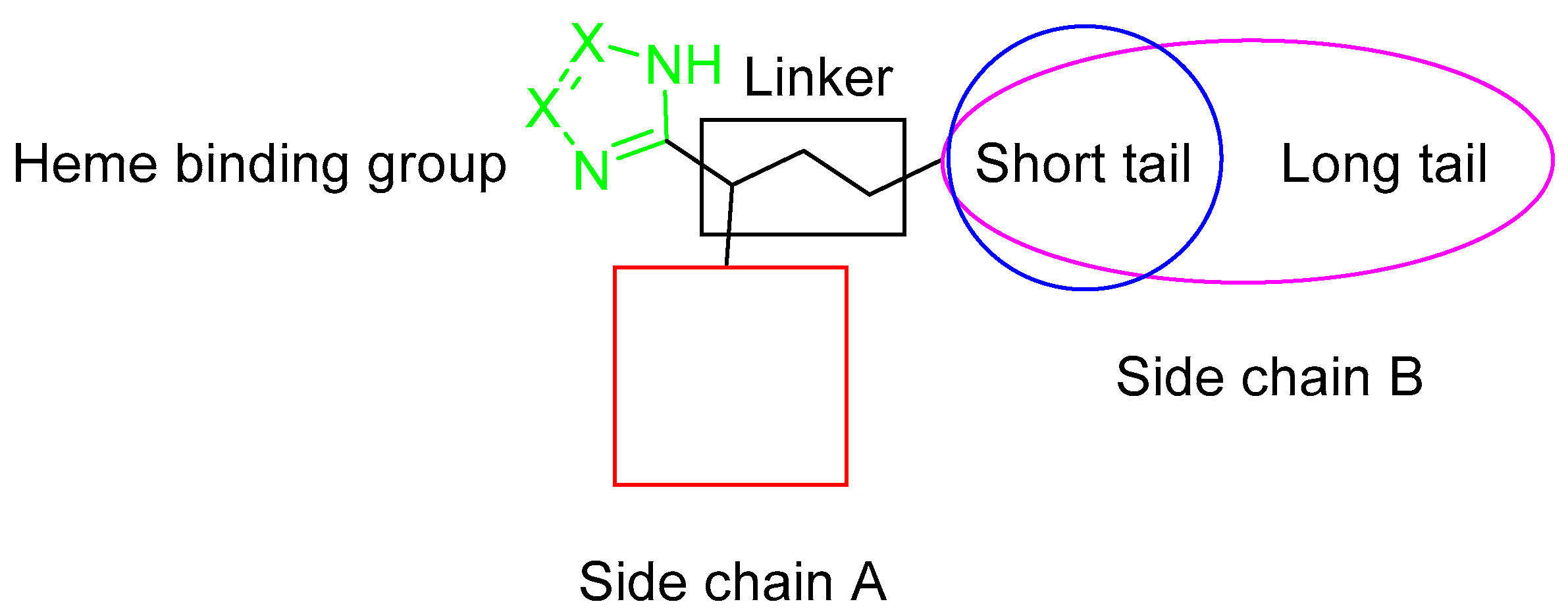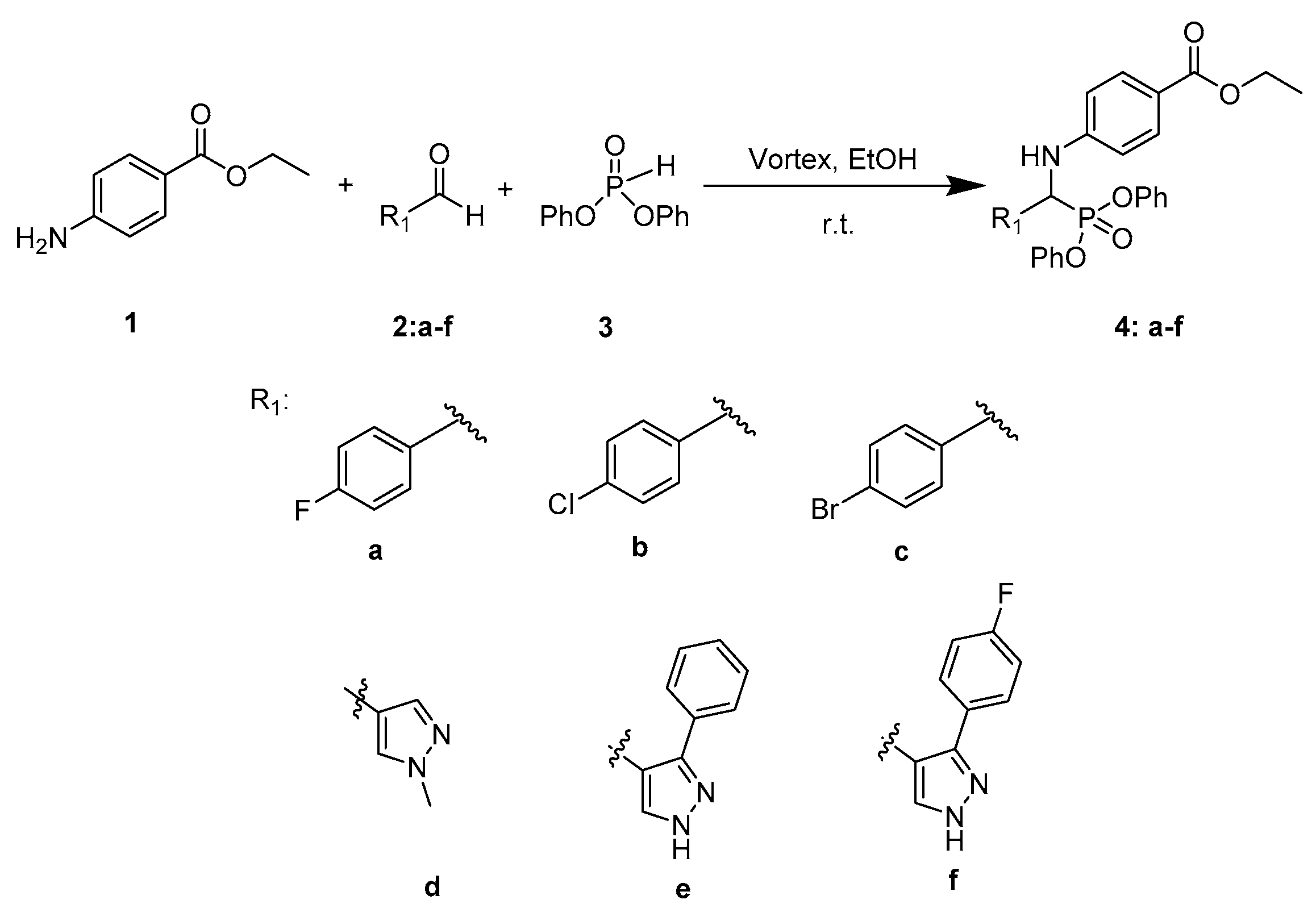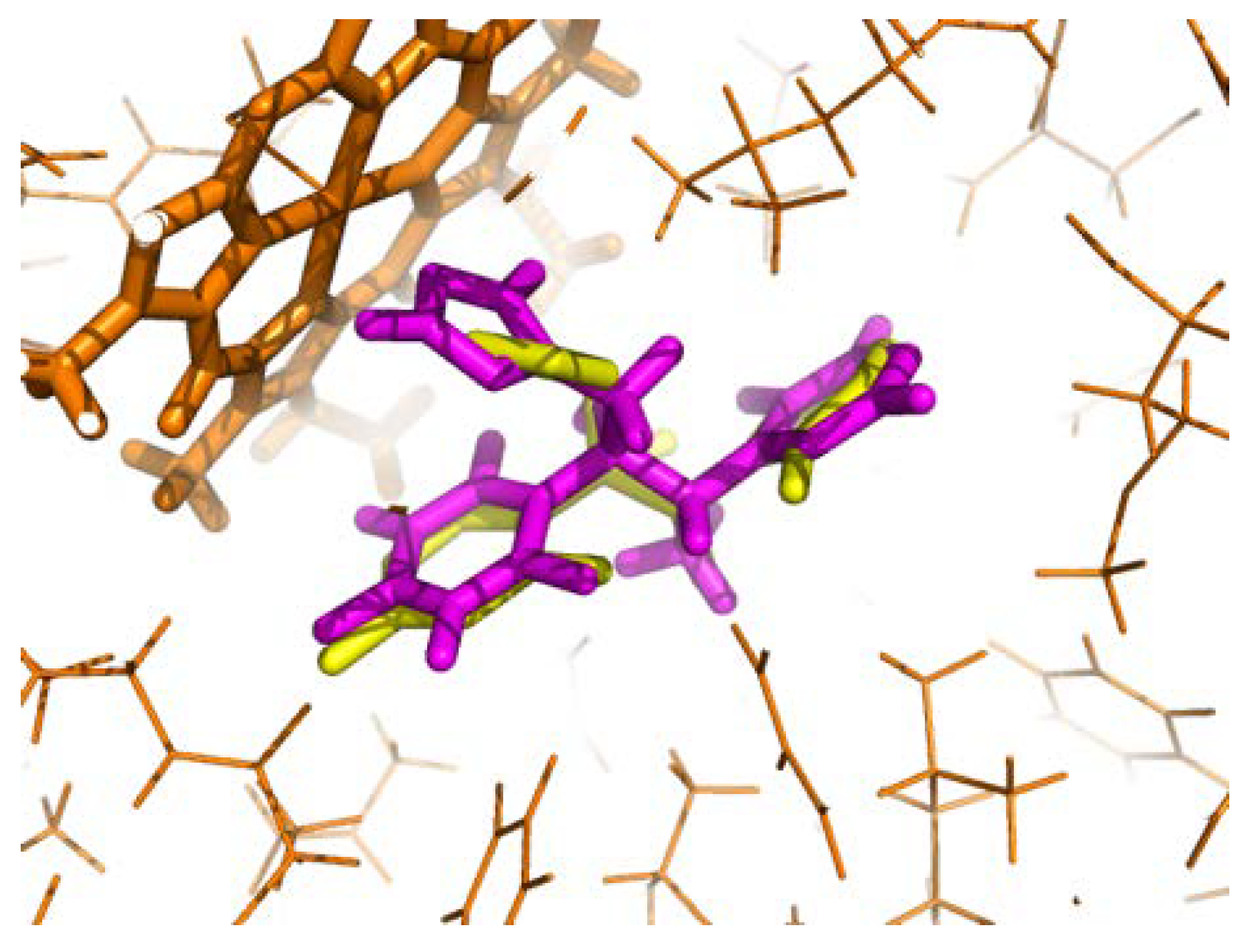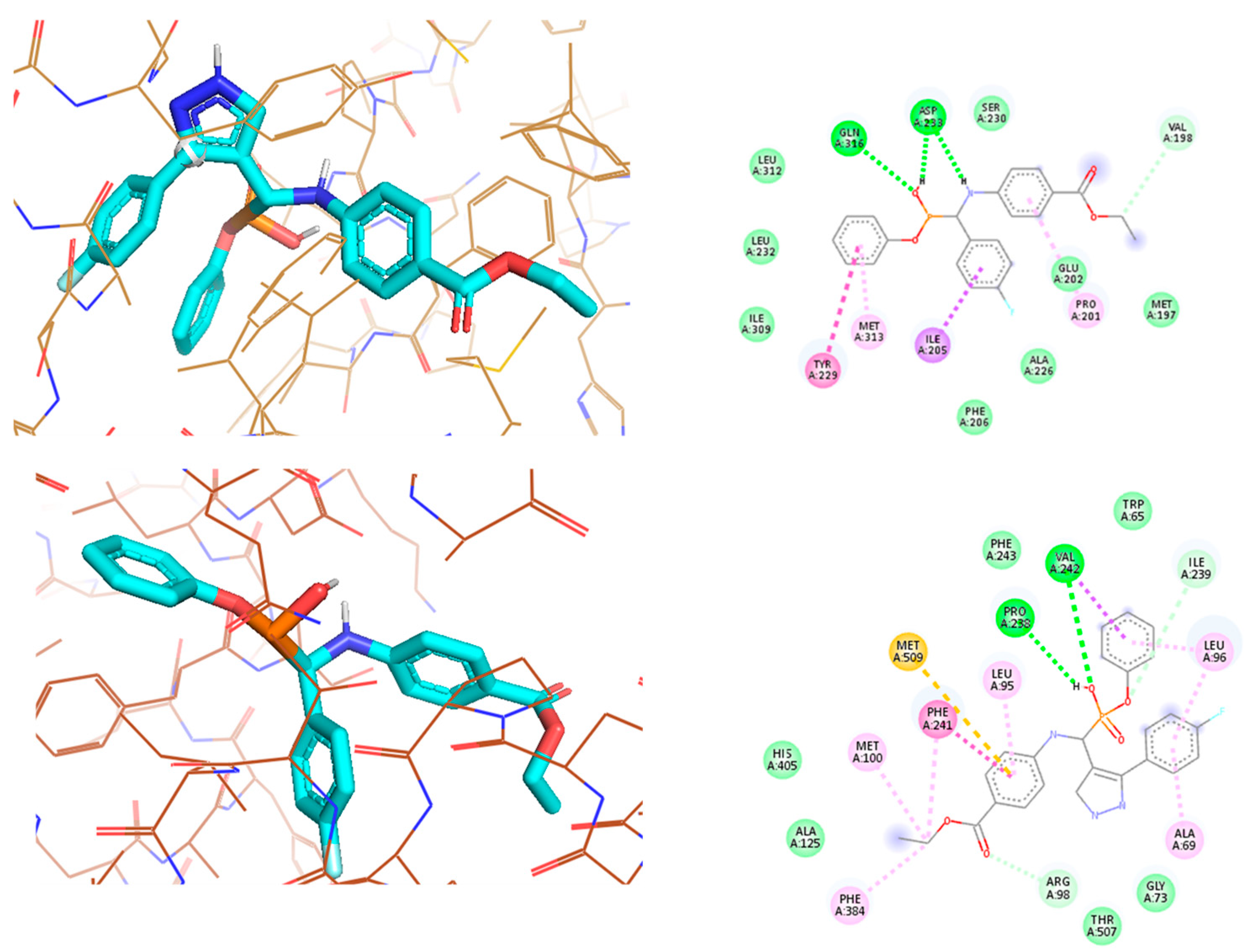Novel α-Aminophosphonates and α-Aminophosphonic Acids: Synthesis, Molecular Docking and Evaluation of Antifungal Activity against Scedosporium Species
Abstract
:1. Introduction
2. Results and Discussion
2.1. Chemistry
2.2. In Vitro Assays
2.3. Antifungal Activity Using the M38-A2 Protocol
2.4. Cytotoxicity
2.5. Molecular Docking
3. Materials and Methods
3.1. Synthesis of α-Aminophosphonates
3.2. Synthesis of Monohydrolyzed α-Aminophosphonates
3.2.1. Ethyl-4-(((diphenoxyphosphoryl)(4-fluorophenyl)methyl)amino)benzoate, 4a
3.2.2. Ethyl-4-(((4-chlorophenyl)(diphenoxyphosphoryl)methyl)amino)benzoate, 4b
3.2.3. Ethyl-4-(((4 bromophenyl)(diphenoxyphosphoryl)methyl)amino)benzoate, 4c
3.2.4. Ethyl-4-(((diphenoxyphosphoryl)(1-methyl-1H-pyrazol-4-yl)methyl)amino)benzoate, 4d
3.2.5. Ethyl-4-(((diphenoxyphosphoryl)(3-phenyl-1H-pyrazol-4-yl)methyl)amino)benzoate, 4e
3.2.6. Ethyl-4-(((diphenoxyphosphoryl)(3-(4-fluorophenyl)-1H-pyrazol-4-yl)methyl)amino)benzoate, 4f
3.2.7. Ethyl-4-(((4-fluorophenyl)(hydroxy(phenoxy)phosphoryl)methyl)amino)benzoate 5a
3.2.8. Ethyl-4-(((4chlorophenyl)(hydroxy(phenoxy)phosphoryl)methyl)amino)benzoate, 5b
3.2.9. Ethyl-4-(((4-bromophenyl)(hydroxy(phenoxy)phosphoryl)methyl)amino)benzoate, 5c
3.2.10. Ethy-l4-(((hydroxy(phenoxy)phosphoryl)(1-methyl-1H-pyrazol-4-yl)methyl)amino)benzoate, 5d
3.2.11. Ethyl-4-(((hydroxy(phenoxy)phosphoryl)(3-phenyl-1H-pyrazol-4-yl)methyl)amino)benzoate, 5e
3.2.12. Ethyl-4-(((3-(4-fluorophenyl)-1H-pyrazol-4-yl)(hydroxy(phenoxy)phosphoryl)methyl)amino)benzoate, 5f
3.3. In Vitro Antifungal Activity
3.4. Evaluation of Cytotoxic Activity
3.4.1. Cell Culture
3.4.2. MTT Assay
3.5. Docking
4. Conclusions
Author Contributions
Funding
Institutional Review Board Statement
Acknowledgments
Conflicts of Interest
Sample Availability
References
- Kainz, K.; Bauer, M.A.; Madeo, F.; Carmona-Gutierrez, D. Fungal Infections in Humans: The Silent Crisis. Microb. Cell Graz Austria 2020, 7, 143–145. [Google Scholar] [CrossRef] [PubMed]
- Tuberculosis. Available online: https://www.who.int/es/news-room/fact-sheets/detail/tuberculosis (accessed on 13 May 2022).
- Prevention, C.-C. For D. C. and. CDC—Malaria—Malaria Worldwide—Impact of Malaria. Available online: https://www.cdc.gov/malaria/malaria_worldwide/impact.html (accessed on 13 May 2022).
- Bongomin, F.; Gago, S.; Oladele, R.O.; Denning, D.W. Global and Multi-National Prevalence of Fungal Diseases—Estimate Precision. J. Fungi 2017, 3, 57. [Google Scholar] [CrossRef] [PubMed]
- Brown, G.D.; Denning, D.W.; Gow, N.A.R.; Levitz, S.M.; Netea, M.G.; White, T.C. Hidden Killers: Human Fungal Infections. Sci. Transl. Med. 2012, 4, 165rv13. [Google Scholar] [CrossRef] [Green Version]
- Revie, N.M.; Iyer, K.R.; Robbins, N.; Cowen, L.E. Antifungal Drug Resistance: Evolution, Mechanisms and Impact. Curr. Opin. Microbiol. 2018, 45, 70–76. [Google Scholar] [CrossRef]
- Mello, T.; Bittencourt, V.; Liporagi-Lopes, L.; Aor, A.; Branquinha, M.; Santos, A. Insights into the Social Life and Obscure Side of Scedosporium/Lomentospora Species: Ubiquitous, Emerging and Multidrug-Resistant Opportunistic Pathogens. Fungal Biol. Rev. 2018, 33, 16–46. [Google Scholar] [CrossRef]
- Ramirez-Garcia, A.; Pellon, A.; Rementeria, A.; Buldain, I.; Barreto-Bergter, E.; Rollin-Pinheiro, R.; de Meirelles, J.V.; Xisto, M.I.D.S.; Ranque, S.; Havlicek, V.; et al. Scedosporium and Lomentospora: An Updated Overview of Underrated Opportunists. Med. Mycol. 2018, 56 (Suppl. S1), S102–S125. [Google Scholar] [CrossRef] [PubMed]
- Rougeron, A.; Giraud, S.; Alastruey-Izquierdo, A.; Cano-Lira, J.; Rainer, J.; Mouhajir, A.; Le Gal, S.; Nevez, G.; Meyer, W.; Bouchara, J.P. Ecology of Scedosporium Species: Present Knowledge and Future Research. Mycopathologia 2018, 183, 185–200. [Google Scholar] [CrossRef]
- Elizondo-Zertuche, M.; de Treviño-Rangel, R.J.; Robledo-Leal, E.; Luna-Rodríguez, C.E.; Martínez-Fierro, M.L.; Rodríguez-Sánchez, I.P.; González, G.M. Molecular Identification and in Vitro Antifungal Susceptibility of Scedosporium Complex Isolates from High-Human-Activity Sites in Mexico. Mycologia 2017, 109, 874–881. [Google Scholar] [CrossRef]
- Ji, H.; Zhang, W.; Zhou, Y.; Zhang, M.; Zhu, J.; Song, Y.; Lü, J.; Zhu, J. A Three-Dimensional Model of Lanosterol 14α-Demethylase of Candida albicans and Its Interaction with Azole Antifungals. J. Med. Chem. 2000, 43, 2493–2505. [Google Scholar] [CrossRef]
- Emami, S.; Ghobadi, E.; Saednia, S.; Hashemi, S.M. Current Advances of Triazole Alcohols Derived from Fluconazole: Design, in vitro and in Silico Studies. Eur. J. Med. Chem. 2019, 170, 173–194. [Google Scholar] [CrossRef]
- Chevreuil, F.; Landreau, A.; Seraphin, D.; Larcher, Gé.; Bouchara, J.-P.; Richomme, P. Synthesis and Antifungal Activity of New Thienyl and Aryl Conazoles. J. Enzym. Inhib. Med. Chem. 2006, 21, 293–303. [Google Scholar] [CrossRef] [PubMed]
- Sheng, C.; Zhang, W.; Ji, H.; Zhang, M.; Song, Y.; Xu, H.; Zhu, J.; Miao, Z.; Jiang, Q.; Yao, J.; et al. Structure-Based Optimization of Azole Antifungal Agents by CoMFA, CoMSIA, and Molecular Docking. J. Med. Chem. 2006, 49, 2512–2525. [Google Scholar] [CrossRef] [PubMed]
- Bartroli, J.; Turmo, E.; Algueró, M.; Boncompte, E.; Vericat, M.L.; Conte, L.; Ramis, J.; Merlos, M.; García-Rafanell, J.; Forn, J. New Azole Antifungals. 3. Synthesis and Antifungal Activity of 3-Substituted-4(3H)-Quinazolinones. J. Med. Chem. 1998, 41, 1869–1882. [Google Scholar] [CrossRef] [PubMed]
- Shafiei, M.; Peyton, L.; Hashemzadeh, M.; Foroumadi, A. History of the Development of Antifungal Azoles: A Review on Structures, SAR, and Mechanism of Action. Bioorg. Chem. 2020, 104, 104240. [Google Scholar] [CrossRef] [PubMed]
- Trösken, E.R.; Adamska, M.; Arand, M.; Zarn, J.A.; Patten, C.; Völkel, W.; Lutz, W.K. Comparison of Lanosterol-14α-Demethylase (CYP51) of Human and Candida albicans for Inhibition by Different Antifungal Azoles. Toxicology 2006, 228, 24–32. [Google Scholar] [CrossRef] [Green Version]
- Fukuoka, T.; Johnston, D.A.; Winslow, C.A.; de Groot, M.J.; Burt, C.; Hitchcock, C.A.; Filler, S.G. Genetic Basis for Differential Activities of Fluconazole and Voriconazole against Candida krusei. Antimicrob. Agents Chemother. 2003, 47, 1213–1219. [Google Scholar] [CrossRef] [Green Version]
- Binjubair, F.A.; Parker, J.E.; Warrilow, A.G.; Puri, K.; Braidley, P.J.; Tatar, E.; Kelly, S.L.; Kelly, D.E.; Simons, C. Small-Molecule Inhibitors Targeting Sterol 14α-Demethylase (CYP51): Synthesis, Molecular Modelling and Evaluation Against Candida albicans. ChemMedChem 2020, 15, 1294–1309. [Google Scholar] [CrossRef]
- Liu, N.; Tu, J.; Dong, G.; Wang, Y.; Sheng, C. Emerging New Targets for the Treatment of Resistant Fungal Infections. J. Med. Chem. 2018, 61, 5484–5511. [Google Scholar] [CrossRef]
- Bhattacharya, A.K.; Rana, K.C.; Pannecouque, C.; De Clercq, E. An Efficient Synthesis of a Hydroxyethylamine (HEA) Isostere and Its α-Aminophosphonate and Phosphoramidate Derivatives as Potential Anti-HIV Agents. ChemMedChem 2012, 7, 1601–1611. [Google Scholar] [CrossRef]
- Varga, P.R.; Keglevich, G. Synthesis of α-Aminophosphonates and Related Derivatives; The Last Decade of the Kabachnik–Fields Reaction. Molecules 2021, 26, 2511. [Google Scholar] [CrossRef]
- Borse, A.U.; Patil, N.L.; Patil, M.N.; Mali, R.S. Efficient One Pot, Three-Component Synthesis of New α-Aminophosphonates and Investigation of Their Antimicrobial Activity. Der Pharma Chemica 2016, 8, 256–261. Available online: https://www.derpharmachemica.com (accessed on 1 June 2022).
- Sivala, M.R.; Devineni, S.R.; Golla, M.; Medarametla, V.; Pothuru, G.K.; Chamarthi, N.R. A Heterogeneous Catalyst, SiO2-ZnBr2: An Efficient Neat Access for α-Aminophosphonates and Antimicrobial Activity Evaluation. J. Chem. Sci. 2016, 128, 1303–1313. [Google Scholar] [CrossRef] [Green Version]
- Chukka, G.; Muppuru, K.M.; Banothu, V.; Battu, R.S.; Addepally, U.; Gandavaram, S.P.; Chamarthi, N.R.; Mandava, R.V.B. Microwave-Assisted One-Pot Synthesis of New α-Aminophosphonates Using ZnBr2-SiO2 as a Catalyst under Solvent-Free Conditions and Their Anticancer Activity. ChemistrySelect 2018, 3, 9778–9784. [Google Scholar] [CrossRef]
- Subba Reddy, G.; Uma Maheswara Rao, K.; Syama Sundar, C.; Sudha, S.S.; Haritha, B.; Swapna, S.; Suresh Reddy, C. Neat Synthesis and Antioxidant Activity of α-Aminophosphonates. Arab. J. Chem. 2014, 7, 833–838. [Google Scholar] [CrossRef] [Green Version]
- Ordóñez, M.; Viveros-Ceballos, J.L.; Cativiela, C.; Sayago, F.J. An Update on the Stereoselective Synthesis of α-Aminophosphonic Acids and Derivatives. Tetrahedon 2015, 71, 1745–1784. [Google Scholar] [CrossRef]
- Ordóñez, M.; Rojas-Cabrera, H.; Cativiela, C. An Overview of Stereoselective Synthesis of α-Aminophosphonic Acids and Derivatives. Tetrahedron 2009, 65, 17–49. [Google Scholar] [CrossRef] [PubMed] [Green Version]
- Shaikh, M.H.; Subhedar, D.D.; Khedkar, V.M.; Shingate, B.B. [Et3NH][HSO4]-Catalyzed One-Pot Solvent Free Syntheses of Functionalized [1,6]-Naphthyridines and Biological Evaluation. Polycycl. Aromat. Compd. 2021. [Google Scholar] [CrossRef]
- Heo, Y.; Cho, D.H.; Mishra, M.K.; Jang, D.O. Efficient One-Pot Synthesis of α-Aminophosphonates from Aldehydes and Ketones Catalyzed by Ytterbium(III) Triflate. Tetrahedron Lett. 2012, 53, 3897–3899. [Google Scholar] [CrossRef]
- Li, X.-C.; Gong, S.-S.; Zeng, D.-Y.; You, Y.-H.; Sun, Q. Highly Efficient Synthesis of α-Aminophosphonates Catalyzed by Hafnium(IV) Chloride. Tetrahedron Lett. 2016, 57, 1782–1785. [Google Scholar] [CrossRef]
- Gao, G.; Chen, M.-N.; Mo, L.-P.; Zhang, Z.-H. Catalyst Free One-Pot Synthesis of α-Aminophosphonates in Aqueous Ethyl Lactate. Phosphorus Sulfur Silicon Relat. Elem. 2019, 194, 528–532. [Google Scholar] [CrossRef]
- Britton, J.; Stubbs, K.A.; Weiss, G.A.; Raston, C.L. Vortex Fluidic Chemical Transformations. Chem.-Eur. J. 2017, 23, 13270–13278. [Google Scholar] [CrossRef] [PubMed]
- Fini, F.; Micheletti, G.; Bernardi, L.; Pettersen, D.; Fochi, M.; Ricci, A. An Easy Entry to Optically Active α-Amino Phosphonic Acid Derivatives Using Phase-Transfer Catalysis (PTC). Chem. Commun. 2008, 36, 4345–4347. [Google Scholar] [CrossRef]
- Rabinowitz, R. Synthesis of Monoesters of Phosphonic Acids. J. Am. Chem. Soc. 1960, 82, 4564–4567. [Google Scholar] [CrossRef]
- Loredo-Calderón, E.L.; Velázquez-Martínez, C.A.; Ramírez-Cabrera, M.A.; Hernández-Fernández, E.; Rivas-Galindo, V.M.; Arredondo Espinoza, E.; López-Cortina, S.T. Synthesis of Novel α-Aminophosphonates under Microwave Irradiation, Biological Evaluation as Antiproliferative Agents and Apoptosis Inducers. Med. Chem. Res. 2019, 28, 2067–2078. [Google Scholar] [CrossRef]
- Eloff, J.N. Avoiding Pitfalls in Determining Antimicrobial Activity of Plant Extracts and Publishing the Results. BMC Complement. Altern. Med. 2019, 19, 106. [Google Scholar] [CrossRef] [Green Version]
- Garcia-Rubio, R.; de Oliveira, H.C.; Rivera, J.; Trevijano-Contador, N. The Fungal Cell Wall: Candida, Cryptococcus, and Aspergillus Species. Front. Microbiol. 2020, 10, 2993. [Google Scholar] [CrossRef]
- Narumoto, O.; Suzuki, J.; Takeda, K.; Tamura, A.; Nagai, H.; Matsui, H. Rechallenge of Voriconazole Successfully Tolerated after Hepatic Toxicity. Respir. Med. Case Rep. 2020, 31, 101191. [Google Scholar] [CrossRef]
- Sant, D.G.; Tupe, S.G.; Ramana, C.V.; Deshpande, M.V. Fungal Cell Membrane-Promising Drug Target for Antifungal Therapy. J. Appl. Microbiol. 2016, 121, 1498–1510. [Google Scholar] [CrossRef] [Green Version]
- Pricopie, A.-I.; Focșan, M.; Ionuț, I.; Marc, G.; Vlase, L.; Găină, L.-I.; Vodnar, D.C.; Simon, E.; Barta, G.; Pîrnău, A.; et al. Novel 2,4-Disubstituted-1,3-Thiazole Derivatives: Synthesis, Anti-Candida Activity Evaluation and Interaction with Bovine Serum Albumine. Molecules 2020, 25, 1079. [Google Scholar] [CrossRef] [Green Version]







| Compound | Time (min) | Yield (%) |
|---|---|---|
| 4a | 15 | 77 |
| 4b | 25 | 65 |
| 4c | 5 | 50 |
| 4d | 15 | 92 |
| 4e | 15 | 98 |
| 4f | 15 | 95 |
| Compound | 1H NMR J Coupling CH-P (Hz) | 13C NMR J Coupling C-P (Hz) | 13C NMR J Coupling C-F (Hz) |
|---|---|---|---|
| 4a | 24.9 | 156.2 | 244.3 |
| 4b | 25.1 | 156.2 | - |
| 4c | 25.4 | 156.4 | - |
| 4d | 22.1 | 163.0 [36] | - |
| 4e | 18.8 | 165.1 | - |
| 4f | 19.9 | 164.7 | 248.1 |
| 5a | 23.4 | 145.1 | 240.3 |
| 5b | 23.6 | 143.3 | - |
| 5c | 23.6 | 139.2 | - |
| 5d | 22.4 | 149.2 | - |
| 5e | 21.7 | 154.3 | - |
| 5f | 21.5 | 153.4 | 246.5 |
| Species /Antifungal | Range (mg/mL) | Range Inhibition Halo (mm/72 h) |
|---|---|---|
| S. apiospermum(00-320) | ||
| VRC | 0.016 | ≥10 mm |
| 4a–f | 1–10 | 1–≥1 mm |
| 5a–f | 1–10 | 2–≥10 mm |
| 5f | 0.1–1 | 7–≥10 mm |
| S. boydii(ZS-025) | ||
| VRC | 0.016 | ≥10 mm |
| 4a–f | 1–10 | 1–≥1 mm |
| 5a–f | 1–10 | 1–≥9 mm |
| 5f | 0.1–1 | 5–≥10 mm |
| S. aurantiacum(MC-070) | ||
| VRC | 0.016 | ≥10 mm |
| 4a–f | 1–10 | 1–≥1 mm |
| 5a–f | 1–10 | 2–≥9 mm |
| 5f | 0.1–1 | 3–≥10 mm |
| Species (n) /Antifungal | MIC100 Range (µg/mL) | MIC100 GM (µg/mL) |
|---|---|---|
| S. apiospermum (5) | ||
| AMB | 2–16 | 6. 96 |
| VRC | 1–4 | 2.64 |
| FLC | 64–>64 | 64 |
| 5f | 640–685 | 648. 76 |
| S. aurantiacum (5) | ||
| AMB | 16–>16 | 16 |
| VRC | 0.5–1 | 0.76 |
| FLC | 32–64 | 55.71 |
| 5f | 700–>700 | 700 |
| S. dehoogii(5) | ||
| AMB | 16–>16 | 16 |
| VRC | 0.5–1 | 0.87 |
| FLC | 32–64 | 36.75 |
| 5f | 700–>700 | 700 |
| S. boydii(5) | ||
| AMB | 8–>16 | 8 |
| VRC | 0.25–1 | 0.44 |
| FLC | 32–>64 | 45.25 |
| 5f | 610–>700 | 672.20 |
| S. angustum(3) | ||
| AMB | 8–>16 | 8 |
| VRC | 0.5–1 | 0.63 |
| FLC | 32–64 | 50.80 |
| 5f | 700 | 700 |
| Antifungal/Compounds (1000 μM) | % Viability |
|---|---|
| VRC | 65.80 ± 1.79 |
| 5a | 55.20 ± 1.79 |
| 5f | 73.51 ± 4.88 |
| Etoposide * | 84.0 ± 2.0 |
Publisher’s Note: MDPI stays neutral with regard to jurisdictional claims in published maps and institutional affiliations. |
© 2022 by the authors. Licensee MDPI, Basel, Switzerland. This article is an open access article distributed under the terms and conditions of the Creative Commons Attribution (CC BY) license (https://creativecommons.org/licenses/by/4.0/).
Share and Cite
Cordero-Díaz, A.; Robledo-Leal, E.; Hernández-Fernández, E.; Hernández-Núñez, E.; Elizondo-Zertuche, M.; López-Cortina, S.T. Novel α-Aminophosphonates and α-Aminophosphonic Acids: Synthesis, Molecular Docking and Evaluation of Antifungal Activity against Scedosporium Species. Molecules 2022, 27, 3886. https://doi.org/10.3390/molecules27123886
Cordero-Díaz A, Robledo-Leal E, Hernández-Fernández E, Hernández-Núñez E, Elizondo-Zertuche M, López-Cortina ST. Novel α-Aminophosphonates and α-Aminophosphonic Acids: Synthesis, Molecular Docking and Evaluation of Antifungal Activity against Scedosporium Species. Molecules. 2022; 27(12):3886. https://doi.org/10.3390/molecules27123886
Chicago/Turabian StyleCordero-Díaz, Anthonny, Efren Robledo-Leal, Eugenio Hernández-Fernández, Emanuel Hernández-Núñez, Mariana Elizondo-Zertuche, and Susana T. López-Cortina. 2022. "Novel α-Aminophosphonates and α-Aminophosphonic Acids: Synthesis, Molecular Docking and Evaluation of Antifungal Activity against Scedosporium Species" Molecules 27, no. 12: 3886. https://doi.org/10.3390/molecules27123886








